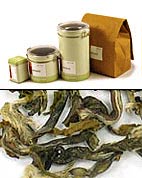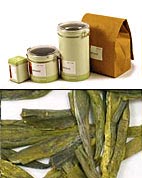Brandelic Artistry
A Land of Ever Changing Creativity and Wonder
Green Tea: the Dance of the Basket-Firers
There is no limit to the complexity, variety, and uniqueness of green tea. There is said by those that say these things that there are more than three thousand types of green tea in China alone. The best way to learn about these fine crafted teas is to delve right in and drink them - with 3000+ types that shouldn't take long should it?
The art of green tea production is a sight to behold, from the early morning pluck to the finishing stages of the basket fire dance. Fresh tea leaves are carried down the mountain in baskets to promote air circulation and to protect the delicate leaves from damage. The leaves then undergoes "Primary Drying" to prevent oxidation. Primary Drying is a shortened version of the drying process (or withering) used to make oxidized tea like black or oolong tea.
While the whole tea making process is an art form, the true magic for green tea is in the manufacture or final drying techniques. Each different method of drying or firing yields different results and in turn unique styles, flavors, and aromas. The primary styles of green tea manufacture range from ancient artisanal methods such as sun-drying, basket firing, and pan-firing to more modern methods of oven-drying, tumbling, and steaming.
One of the most interesting methods of dying to watch is basket-firing. Experienced tea masters stand, one one each side of a two foot tall bamboo firing basket that is placed over a pile of charcoal embers. The basket is only kept over the heat for about a minute before it is removed to be fluffed by gently tapping the sides of the basket. The tea leaves are fluffed and heated repeatedly by this method in a well timed dance for about fifteen to twenty minutes. The tea master's perfect unity and mirror movements is truly a wonderful sight to observe.
A modern adaptation of basket-fired tea is called baked tea. Rather than tossing the leaf the leaves undergo a delicate twist and roll by hand while the hot air changes from hot to warm to cool in a controlled rotating basis. A wonderful example of this is Green Snail Spring tea, a famous green tea from the Jiangsu Province of China.
 |
Try Pi Lo Chun tea a famous basket fired tea called Green Snail Spring in reference to it's spiral shaped leaves."A light, refreshing green tea that carries with it a natural minty flavor and aroma. Very nice. Very refreshing. My favorite tea." - - - Wesley |
Pan-firing is another great method of green tea manufacture. In just one process it fixes the "juice" within the leaf, seals in the flavor, and dries the leaf to the correct moisture content, while adding a delightful toastiness to the finished taste. A traditional method of pan firing uses a wood fired double pan in a hammered wok-like pan set over a separate heat source. A more modern method involves a thermostat controlled electric pan. In both methods the leaves are repeatedly pressed to maintain contact with the heated surface of the pan, thus pan-fired teas are identified by their flat appearance and slight luster due to the use of tea-seed oil to help the leaves glide around the pan and prevent burning.
Try Dragonwell tea, a refreshingly smooth, sweet and delicate pan-fired green tea."A very pleasent tea, at all phases, warm and cold. I steep mine all day long in a nalgene bottle, so I experienced it in all temperatures and steepages. When it has been steeping for a long time, it develops a slightly licorice sweet sort of aftertaste which was surprisingly pleasent." - - -Molly |
 |
Select a Gallery:
- Brandi's Galleries:
Figurine/Pottery Gallery
Photography Gallery
Drawing Gallery
Jewelry Gallery - Chris's Galleries:
Photography Gallery
Drawing Gallery
Jewelry Gallery

